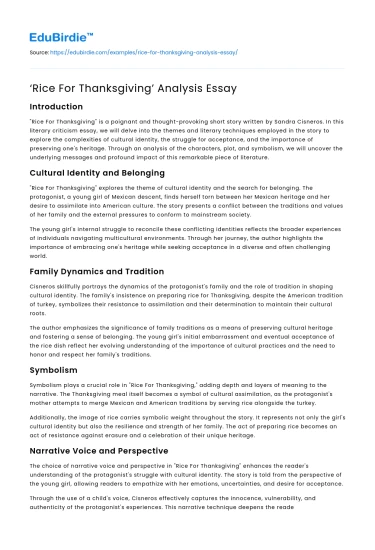Introduction
"Rice For Thanksgiving" is a poignant and thought-provoking short story written by Sandra Cisneros. In this literary criticism essay, we will delve into the themes and literary techniques employed in the story to explore the complexities of cultural identity, the struggle for acceptance, and the importance of preserving one's heritage. Through an analysis of the characters, plot, and symbolism, we will uncover the underlying messages and profound impact of this remarkable piece of literature.
Cultural Identity and Belonging
"Rice For Thanksgiving" explores the theme of cultural identity and the search for belonging. The protagonist, a young girl of Mexican descent, finds herself torn between her Mexican heritage and her desire to assimilate into American culture. The story presents a conflict between the traditions and values of her family and the external pressures to conform to mainstream society.
Save your time!
We can take care of your essay
- Proper editing and formatting
- Free revision, title page, and bibliography
- Flexible prices and money-back guarantee
The young girl's internal struggle to reconcile these conflicting identities reflects the broader experiences of individuals navigating multicultural environments. Through her journey, the author highlights the importance of embracing one's heritage while seeking acceptance in a diverse and often challenging world.
Family Dynamics and Tradition
Cisneros skillfully portrays the dynamics of the protagonist's family and the role of tradition in shaping cultural identity. The family's insistence on preparing rice for Thanksgiving, despite the American tradition of turkey, symbolizes their resistance to assimilation and their determination to maintain their cultural roots.
The author emphasizes the significance of family traditions as a means of preserving cultural heritage and fostering a sense of belonging. The young girl's initial embarrassment and eventual acceptance of the rice dish reflect her evolving understanding of the importance of cultural practices and the need to honor and respect her family's traditions.
Symbolism
Symbolism plays a crucial role in "Rice For Thanksgiving," adding depth and layers of meaning to the narrative. The Thanksgiving meal itself becomes a symbol of cultural assimilation, as the protagonist's mother attempts to merge Mexican and American traditions by serving rice alongside the turkey.
Additionally, the image of rice carries symbolic weight throughout the story. It represents not only the girl's cultural identity but also the resilience and strength of her family. The act of preparing rice becomes an act of resistance against erasure and a celebration of their unique heritage.
Narrative Voice and Perspective
The choice of narrative voice and perspective in "Rice For Thanksgiving" enhances the reader's understanding of the protagonist's struggle with cultural identity. The story is told from the perspective of the young girl, allowing readers to empathize with her emotions, uncertainties, and desire for acceptance.
Through the use of a child's voice, Cisneros effectively captures the innocence, vulnerability, and authenticity of the protagonist's experiences. This narrative technique deepens the reader's connection to the character and amplifies the impact of her journey of self-discovery.
Conclusion
"Rice For Thanksgiving" is a powerful and resonant piece of literature that explores the complexities of cultural identity, the struggle for acceptance, and the importance of preserving one's heritage. Through skillful storytelling, Sandra Cisneros captures the internal conflict of the young protagonist as she navigates the tension between her Mexican roots and her desire to assimilate into American society.
The story serves as a poignant reminder of the significance of cultural traditions, the resilience of family bonds, and the importance of embracing one's identity. "Rice For Thanksgiving" invites readers to reflect on their own experiences with cultural identity and the challenges of belonging in a multicultural world. By doing so, the story encourages a celebration of diversity and an appreciation for the richness that different cultural backgrounds bring to our collective human experience






 Stuck on your essay?
Stuck on your essay?

